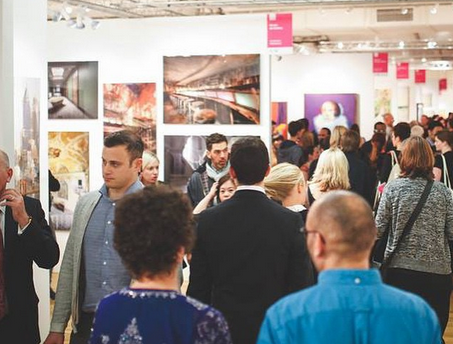Once a year the Affordable Art Fair takes on New York City. For five days in Chelsea, collectors scour the inventory for an investment piece, hobbyists browse the fair for inspiration, and beginners flock with excitement to buy their first painting.
My online art gallery, UGallery.com, has attended the fair for many years and witnesses the thrill that buying original art brings to clients. As we like to say, "you don't know what it is 'til you've had it, but once you've had it you can never go back."
Whether you're attending the fair this weekend, gallery hopping in your town, or buying a piece of original art online, we created a cheat sheet of the top things to look for.
What to look for when choosing art:
Cohesive Style: As an artist evolves, they typically start to focus on a specific subject or technique. This creates repetition in their work, and repetition leads to more mature, refined work.
Originality: As an artist evolves, their work starts to be their own. They transition from mimicking others to creating unique art. Look for artists who have progressed to their own styles and themes.
Content: Select art that is original, intriguing and legible. Seek out pieces that stimulate your senses, tell stories, and lead to interesting discussions. Be careful with emotionally dark or violent art; it is often powerful at first, but it isn't as versatile and you may get tired of it over time.
Emotional Connection: Great art leaves a lasting impression. Look for pieces that keep your attention even after you've stopped looking at them.
Artist's Background: Avoid looking only for artists you have formal training (some of the best artists are self-taught!), but do look for signs of dedication and credibility. At UGallery, we believe art is primarily a learned skill. Well-prepared art takes an incredible amount of thought and technique, so look for artists that demonstrate a love and commitment to their practice.
Balance Between Process and Product: Look for balance between conceptual meaning and the finished piece. Great art must challenge the viewer and offer new perspectives. For the purpose of display and collecting, it must also be well constructed and ready to present.
Quality: Pay attention to the quality of the materials and whether a piece is well-finished. This also demonstrates the artist's dedication and practice.
We also created a quick cheat sheet of questions to ask yourself when browsing the inventory. Happy art hunting!
10 Questions to Ask Yourself When Buying Art:
1. Do I have an emotional reaction to the piece?
2. Does the piece bring me into it, or am I looking at it?
3. Does the color palette stimulate my senses?
4. Does the composition guide my eye through the piece?
5. Do I understand the piece? Is it conceptual and thought-provoking without being too complicated to understand?
6. Is there anything unique about in the creation process that sets the work apart?
7. Is the artist working in a cohesive style? (this indicates focus, repetition, and practice which leads to more refined work)
8. Is the artist building on a previous artist's work or an artistic movement?
9. Is the piece well constructed? Is it made of materials that will age well? Or technology that may go out of date?
10. Do I continue to think about the work and its meaning even after I've stopped looking at it? Does the work have staying power?

